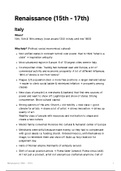Summary
Summary History of Western Arts and Culture | Introduction to the humanities
- Course
- Institution
- Book
Complete summary for term 1 IBACS. Very easy to understand and has ALL the necessary materials. Cum Laude final course grade. Janetta Rebold Benton & Robert DiYanni (2012) Arts and culture. An introduction to the humanities | chapters 1 - 6 & 10 - 12 | History western arts and culture | IBACS/I...
[Show more]




